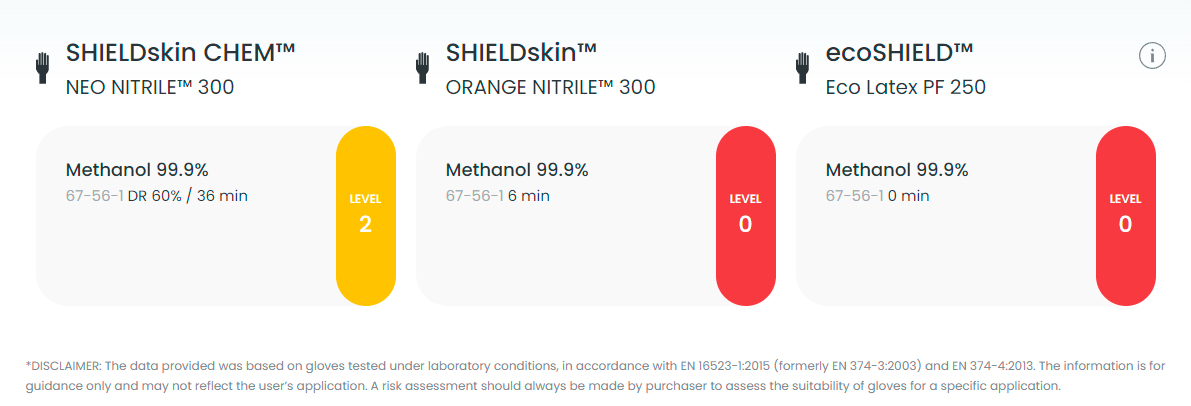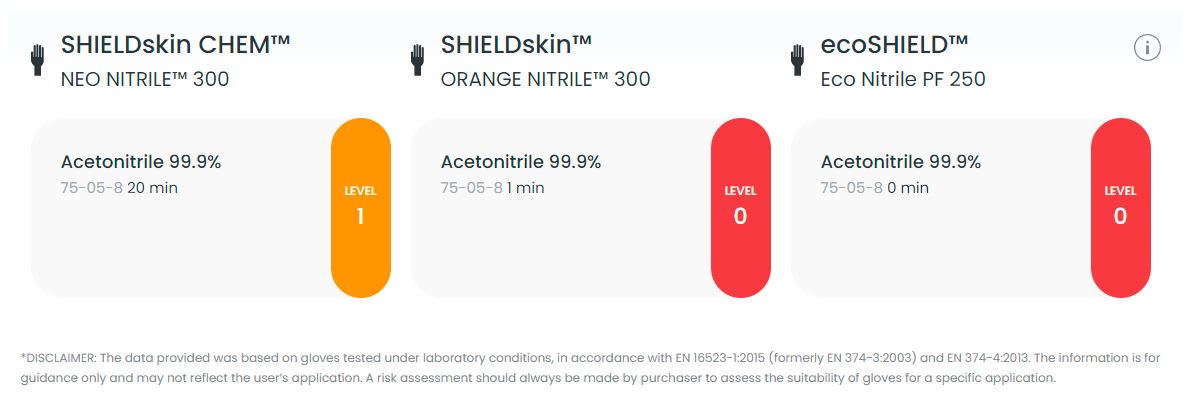Wearing suitable single-use gloves during HPLC analyses

High-performance or ultra-high-performance liquid chromatography (HPLC and UHPLC) is a methodology frequently used in biochemistry and biotechnology laboratories. This method offers unrivalled precision in the separation and analysis of complex mixtures. However, the HPLC analysis process involves handling chemicals such as acetonitrile or methanol (mobile phases), which are harmful (H312) / toxic (H311) through skin contact. It is therefore essential to wear single-use gloves certified as category III PPE, suitable for these two chemicals.
Why are gloves important for HPLC analysis?
HPLC columns (stationary phase) are expensive consumables that are sensitive to clogging. To maximise column life, it is essential to use the highest quality solvents available (HPLC/MS grade). It is also recommended to filter and degas the mobile phase.
The HPLC method involves handling and therefore the potential exposure of technicians to chemicals hazardous to human health.
This exposure can take place:
- During the preparation of the mobile phases (solvents) used for HPLC analysis (filtration and degassing);
- During the connection/change of solvent bottles (handling of tubing, risk of spillage/breakage when changing bottles);
- During the sample preparation/injection phase.
When it comes to handling chemicals, the importance of proper hand protection cannot be overstated. Single-use gloves act as the first line of defence. However, not all gloves offer the same protection against chemicals.
Why is the performance of disposable gloves against chemicals important?
The HPLC method involves the use of a variety of solvents and chemicals, each with its own unique properties. The gloves used must therefore be compatible with these substances, to avoid their degradation and the accidental exposure of technicians to harmful chemicals. Opting for gloves that are specially adapted to resist the chemical being handled helps to guarantee operator safety.
How do you choose gloves based on their level of performance in relation to the chemical used?
The key is to know how resistant a glove is to a wide range of chemicals commonly used in HPLC processes. This allows researchers to handle samples with complete confidence and safety. To achieve this, it is essential to ensure that the single-use gloves used have been tested for permeation and/or degradation by the chemical used in the HPLC analysis.
The glove permeation test and degradation test must be carried out in accordance with standards EN 16523-1:2015+A1:2018 and ISO 374-4:2019. These tests measure the barrier effectiveness of a glove to a chemical product.
Only the results of these tests, expressed as the chemical’s “breakthrough time”, can provide information on the level of protection provided by the disposable gloves used. See our Chemical resistance guide to find out and compare the permeation results of our gloves.
What physical characteristics should gloves suitable for HPLC analysis have?
What glove material should I choose?
For example, compare the permeation time (breakthrough time in minutes) of the three gloves below:For example, compare the permeation time (breakthrough time in minutes) of the three gloves below:
- The SHIELDskin CHEM™ NEO NITRILE™ 300 glove, with a thickness of 0.31 mm
- The SHIELDskin™ ORANGE NITRILE™ 300 glove, with a thickness of 0.14 mm
- The ecoSHIELD™ Eco Latex PF 250 glove, with a thickness of 0.16 mm
for methanol (CAS 67-56-1), a chemical frequently used in HPLC analyses. Here are the results:

(Screenshot of our online Chemical resistance guide)
In terms of materials, there is no doubt that nitrile gloves perform better than latex gloves when it comes to protection against chemicals.
Why does the thickness of the glove matter?
The thickness of the glove is also an essential criterion.
If we compare the permeation time of SHIELD Scientific nitrile gloves operating on the “traffic light” principle (red glove - high risk protection, orange glove - intermediate risk protection, green glove - standard use):
- The SHIELDskin CHEM™ NEO NITRILE™ 300 glove, with a thickness of 0.31 mm
- The SHIELDskin™ ORANGE NITRILE™ 300 glove, with a thickness of 0.14 mm
- The ecoSHIELD™ Eco Nitrile PF 250 glove, with a thickness of 0.10 mm
for acetonitrile (CAS 75-05-8), a chemical also widely used in HPLC analysis. Here are the results:

(Screenshot of our online Chemical resistance guide)
We can see that the result for the 0.31 mm glove is much better than the 0.14 mm and 0.10 mm gloves.
We’ll leave you to imagine what it’s like with thin 0.07 or 0.08 mm gloves!
Can gloves appropriate for HPLC handling provide comfort and dexterity?
As well as chemical resistance, comfort and dexterity are essential criteria for technicians who spend long hours every day carrying out complex operations. Single-use gloves, designed for work on HPLC columns, must therefore offer the right balance, providing the necessary protection without sacrificing tactile sensitivity. This allows precise handling of samples and instruments.
What are the recommendations for selecting suitable HPLC gloves?
The choice must be made carefully, depending on the HPLC process and therefore the chemicals handled.
Choose gloves that are known to be resistant to the chemicals and compatible with the HPLC solvents you are handling.
Don’t forget to change your gloves regularly based on the breakthrough time given in the technical data sheet for your gloves, and at the very least, on the slightest contact with the chemical product.
Inspect the integrity of your gloves for any signs of damage or deterioration, and replace them promptly if necessary.
All life sciences laboratory staff must be aware of the importance of using suitable gloves and be trained in their correct selection, use and disposal.
In the complex world of HPLC, every detail counts. The choice of suitable single-use gloves is above all a question of protection. By giving priority to the compatibility of gloves with the chemicals used, laboratories can improve the protection of their technicians and researchers. When it comes to efficiency and safety, the right gloves make all the difference.
To help you select the right gloves for your laboratory process, contact a SHIELD Scientific sales representative.
Share this interesting information
